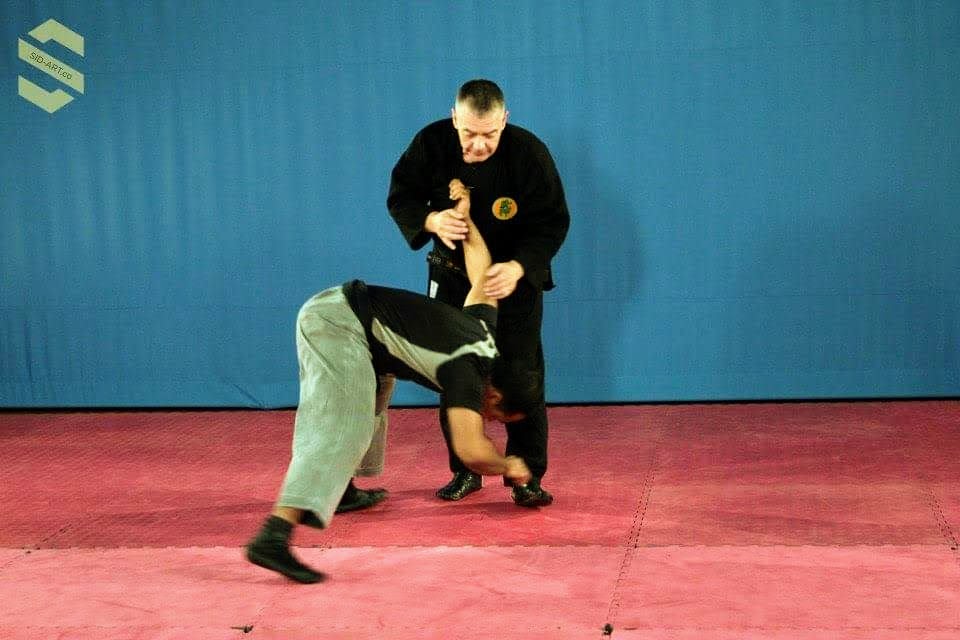From Shiro Kuma by kumablog

In the Kukishin ryū, there is one central concept that many don’t know, and it is called “Jūjiro”. (1) With the pandemic, everyone experiences difficult times, and it seems that many of us should be reminded of some basic concepts. Jūjiro is one of them.
Bujinkan practitioners often do not understand or never heard of what is Jūjiro.
Let me refresh your memories about the Kukishin Ryū. When you receive an attack, you must pivot at a 90-degree angle with the body, weapon or both. Staying in line with the opponent is the fastest way to lose a fight. Sport is different as you don’t die in it. If you are defeated in a championship, only your ego is killed, momentarily.
Olympic fencers fight in line, Kendōka always remains in line. My Mandalorian friends would say, “That is not the way.” Lines are direct; therefore, they are never the best. Fencing and Kendō would get more exciting and realistic the day fencers and Kendōka are allowed to turn around each other. Because that is what you would do in a real encounter. But if sport can be a “way of life” for some, it is definitely not a real-life and death situation. Budō is not a sport, rather an ancient military system.
In Japan, Sensei teaches that Jūjiro is used in the Kukishin when possible. Jūjiro consists of moving perpendicular to the attack or using the weapons perpendicular to the target. You apply Jūjiro against a human or a weapon. If you test it in your next training, you will see how powerful it is. Jūjiro creates more freedom in your actions and opens up more possibilities for your taijutsu.
But there is more to this concept. When you think about the movements, you limit yourself to the physical world, and the material world is only the Omote.
There is also an Ura aspect we can use in the mental world. And to explain this, I will need the support of my old friends Laozi and Sunzi.
In the art of war, Sunzi says that “In battle, there are not more than two methods of attack – the direct and the indirect; yet these two in combination give rise to an endless series of manoeuvres. The direct and the indirect lead on to each other in turn, and it is like moving in a circle – you never come to an end. He adds that “the meeting takes place head-on, and the victory is obtained from an angle”. This direct vs indirect can be related to the cultural differences between the East and the West. In the East, indirect actions are always preferred to direct ones. That is why the Japanese never say “no” but always find a positive way to be negative. For example, when I asked a question to sensei, he would do one of two things: he would answer my question or say something like “step by step.” That was his way to say “no” without being negative (even though he is being negative).
This Asian vision of life is beautifully explained in a book by Francois Jullien, a French sinologist. In one of his books titled “Detour and Access: Strategies of Meaning in China and Greece,” he gives a few examples of direct vs indirect action. (2) By not confronting Uke’s actions head-on, you can redirect his intent in other directions. We are tempted to confront the other in a verbal argument instead of accompanying his vision and tilting it. This is the art of negotiation. Nothing good comes from confrontation. This is the “no fight” attitude or “tatakainai.” (3)
In the famous Taoteching, Laozi says, “don’t do anything and nothing will be left undone”, which you can understand as “when you oppose someone or something, your actions influence the outcome of the encounter. By not going head-on, you don’t create any unforeseen consequences. Direct confrontation is the opposite of the teaching of Tao. One day I had the chance to speak with the Dzogchen master of the Dalai Lama told me that “Opposing In and Yō is creating duality instead of unity, this is not the Madhyamaka.” (4) (5)
In battle, this is the direct approach that has to be avoided. Sunzi adds, “by rectitude, we make order reign, we use the troops at an angle. ”Both the direct and the indirect approaches are in use; the timing is different and should not be mixed. This no-confrontation defines Hatsumi Sensei’s Budō, and it is a very profound lesson for our lives.
Avoiding direct opposition with others is the best way for negotiating. The Covid has dramatically changed the way we live. On the planet, many groups are fighting each other violently. This is the time of direct confrontation and thus of duality. Please consider going indirectly with the flow instead of rebelling uselessly. The way of Budō is a way of wisdom. Fight what you can change by yourself and what is beyond your possibilities.
Ninpō Taijutsu teaches us the way of adaptation.
So, constantly adapt to the situation, and use Jūjiro a little more at your dōjō and outside in real life.
_____________________________________________
1 Jūjiro 十字路, crossroads or intersection
3 戦い無い, tatakainai: non existent fight, no fight
4 In-Yō is the Chinese for Yin-Yang
5 中觀見, Madhyamaka: https://en.wikipedia.org/wiki/Madhyamaka…
Read More